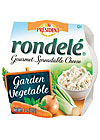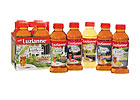
CHICAGO-Organic Valley Family of Farms had one of the busiest booths at the All Things Organic show here at the end of April-the co-op is a leader in the organic foods industry, after all.
But one of the most important talking points for the Organic Valley staff and member farmers had more to do with packaging than with the company’s excellent organic milk
“These are brand new, and we think they are going to be very successful, especially for things like cream and half and half,” said Eric Newman, v.p. of sales for Organic Valley, as he held a one-liter Tetra Pak carton, labeled with Organic Valley graphics.
“Think Outside the Fridge!” reads a heading in the section of the company’s fluid milk sell sheet that highlights the aseptic offerings. In addition to the liters, there are new flavors SKUs and new multipack configurations for the single serve Tetra Prisma products Organic Valley introduced a couple years ago.
The back page of the 4-page sheet is a full page ad for the full aseptic line.
“Convenient and practical,” it reads “easier to ship, easier to stock, and easier on the environment.”
Beneath that message is a citation claiming that consumer acceptance for shelf stable packaging is growing. Many Dairy Foods readers will have heard that claim before, only to find that milk in the U.S. is still shipped and sold in the cold chain.
For the past year or so, Tetra Pak is making the argument that the aseptic carton is really the package for the 21st Century. There are those elsewhere in the packaging industry who will argue otherwise, and there are example companies-Organic Valley included-who have found that there is no one perfect package for milk.
But with fuel prices now 3 to 4 times what they were 10 years ago, and growing pressure on companies to demonstrate that they are doing something to reduce their carbon footprint, processors and product marketers who can find a fit with their business models may soon take another look at aseptic.
Meanwhile, there are plenty of considerations beyond carbon footprint when it comes to packaging milk and other dairy products. Key among them is shelf appeal. Packaging can still be a product’s best marketing ally. We’ll look at some great examples from IDFA’s Achieving Excellence Awards later in this piece.

Special milk, special market
Straus Family Creamery in Marshall, Calif., is a vertically integrated organic farmstead creamery that sells its milk and dairy products primarily in the neighboring San Francisco market. Its milk is so good, that it is the sole milk source for award winning cheesemakers Cowgirl Creamery. Straus has a deep dedication to protecting both the purity of its milk and products, and the natural environment.Straus packaging milk in both glass bottles and HDPE, and the company’s website includes a section that explains the thinking behind Straus’s packaging choices, under the heading “Sometimes there’s no easy answer.”
We began Straus Family Creamery by putting our milk in glass bottles. Milk poured from glass containers simply tastes better than milk that has been stored in plastic or cartons. And it works out great for the environment. Our customers have prevented a LOT of plastic from going into landfills.
However, we bottle a small percentage of our milk in opaque HDPE #2 plastic half-gallon and gallon containers. Why would a glass-bottle milk company package milk in plastic? Good question! We felt that gallon bottles were too heavy and too easily broken to be practical for families to use. And like any material, plastic offers certain advantages.
Plastic weighs 37% less than glass, so it saves fuel during its trip from the creamery to stores. And the HDPE #2 opaque plastic is recycled at a higher rate than any other plastic and is accepted by every community recycling program. Milk cartons are not recycled due to their paper-plastic composition. Plus, some retailers and customers who are ready to try organic products for the first time still demand plastic. We want to offer them the chance to choose organic products and learn about renewable resources and sustainable family farming. Once they’ve HERD about our cows, they’ll MOOOOVE on over to glass! (Sorry about that dairy humor.)
It’s obvious that Straus has given this a good deal of thought, and while it has a preference for glass, it has found that no one packaging format meets its needs completely.
Where Straus is focused on a local market, selling milk from a single, dedicated herd, Organic Valley, the nation’s largest organic cooperative has farmers, co-packing arrangements, and distribution from coast to coast. In order to promote a regional milk distribution model that it believes to be more beneficial to family farmers and consumers and easier on the environment, much of Organic Valley’s milk is sold under its regional “Pastures” brands such as Texas Pastures and Northeast Pastures. These products are fresh pasteurized rather than UHT and they are put into quart and half-gallon gabletops, and in HDPE half-gallon and gallon jugs.
For products sold nationally, Organic Valley uses a UHT processing and is sold primarily in quart and half-gal gabletops. The new shelf stable products augments this line, providing non-cold chain distribution and storage options.
The fact that both of these green companies find no need to settle on one type of milk package shows that there really is not an easy answer to the sustainability question. That is unless you ask Tetra Pak.
Taking the chill out
For the past year or so, Tetra Pak has been telling the story of why the aseptically packaged products in a paperboard container is the packaging solution of the future for milk.A tiny booklet (made from recycled paper) was presented to dairy processors at IDFA’s Dairy Forum in January. That booklet points to several advantages that paperboard has over plastics and disposable glass. These include optimal package-to-product weight ratio, renewability, space efficiency, and recyclability.
Tetra Pak point out that the separation of materials is practical and is taking place even in the U.S. When combined with the ability to ship and store at ambient temperatures, aseptic brick packaging stacks up very well for any product that’s traveling outside of an extremely local market.
Even if one agrees with the assumption that aseptic milk will be embraced by consumers, it would take time to convert any significant portion of the U.S. milk production to an ambient production and distribution chain. Aseptic packages cannot be produced on standard processing and filling equipment.
But the industry is changing, and the growing part of the business often involves different business models, like the one developed by Organic Valley. The future of dairy and new packaging solutions could be around the corner.

And the winner is....
Earlier this year IDFA presented its annual Achieving Excellence Awards with Dairy Foods serving as sponsor. The program recognizes the outstanding marketing and advertising efforts of U.S. dairy processors, and aptly includes a category for outstanding packaging.The winner for best overall package design was Organic Valley for its aseptic single serve milk line. The combination of a cow-spot design with the versatility of shelf-stable aseptic packaging boosted sales to families in 2007. The concept was extended from single units to 4-packs and 24-pack cases. Sales of white and chocolate varieties saw high triple-digit increases in both mainstream grocery and natural food channels, and now Organic Valley is rolling out strawberry and vanilla extensions.
In the frozen novelty category, the new FrozFruit SuperFruit package from Wells Dairy clearly communicates the product is made with large pieces of real fruit, emphasizes the FrozFruit brand with Blue Bunny in an endorsed position, ensures the brand promise of “Uncontained Delight” and includes English and Spanish wording.
Breyers Yogurt Co. was recognized in the cultured category for its YoCrunch Halloween packaging aimed to boost sales during a traditionally slow period, drive brand awareness and bring some fun to the category. The five SKUs, featuring ghosts and goblins, were the first seasonal YoCrunch cup for Halloween.
In the Package Redesign category, DCI Cheese took the overall honors for an update of its specialty cheese product lines to convey a more contemporary look with a modern, sophisticated brand image.
Lactalis USA was recognized in the cheese category for creating greater visual distinction for its Rondelé brand. The brand was placed under the President umbrella to enhance quality perception, and an outdoor scene lends an accessible and inviting feel to the design. Use of fresh ingredients, such as vegetables and herbs, is stressed.
In the milk segment, the honors went to Tuscan Dairy Farms for updating its packaging to strengthen its position as the top brand in the New York Metro area. The label design is bold and simple to create a billboard effect on shelf. While modern, the label also stresses its “since 1918” heritage, a green color to emphasize freshness and a flying cow image to demonstrate energy and vibrancy.
Perry’s Ice Cream took the prize in the freezer aisle. A new two-piece “sqround” boasts a resealable snaptight lid with a tamper-evident freshness seal. A different color scheme was created for premium, light, no sugar added and yogurt varieties. The new packaging was featured prominently in the company’s multimedia 75th anniversary promotions.
Early adapters
New technologies in packaging are always on the horizon, and in 2008 some of them are finding applications in dairy and beverages.Reily Foods Co., New Orleans recently launched a new ready-to-drink iced tea line in a 16-ounce, pedestal-based, custom PET bottle from Amcor PET Packaging. The new design is patterned after the tall graceful columns found in Southern architecture. The graphics support the positioning by incorporating images of verandas, white rocking chairs and Spanish moss.
Reily’s Luzianne brand has long been synonymous in the South with quality food and beverage products formulated or blended with southern taste preferences in mind. Its heritage tea products first entered the market in 1932 and have been recently available in both retail (bags) and institutional channels (filter bags, loose tea and concentrate).
“The RTD category has really exploded over the past several years. Consumer research told us that our consumers were ready for a ‘turnkey’ alternative-products that require less work,” explains Nicole Champine, marketing manager. “As a company with a rich tea history, it made a lot of sense for us to be there.”
Having made the decision to go forward with RTD formulations, the next question was what container type should be used to bring the line extension to market. Initially, Reily asked its creative agency Interbrand, New York City, to develop some sketches. At that time, the company was thinking of launching in a glass bottle, but the company ultimately opted for PET.
Finally, from Italy, Brescia Milk Depot adopted an innovative packaging solution to help it meet the needs of a small but important segment. Using a hot melt technology, it now applies code dating information on its stretch sleeve label in Braille, making it the brand of choice for the visually impaired.